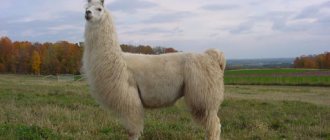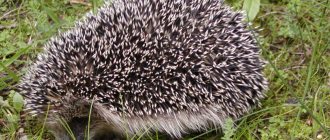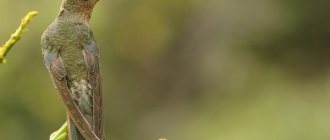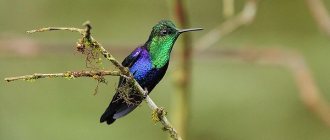The honey badger is an extraordinary animal; if you don’t know what this animal looks like, you won’t understand what family this creature is from. It has a curious coat color: on the back and top of the head the fur is gray-white, and the rest of the body is black. If you look at a badger while standing opposite it, you will notice that its muzzle resembles that of a bear, the length of the body without a tail is 75-80 cm. The weight of the animal is 8-11 kg, males are larger than females, but the difference in size is not as noticeable as in other animals.
The habitat where the honey badger lives
Their entire body, with the exception of the belly, is protected by thick skin, which is not so easy for predators to bite through, so honey badgers are not afraid of lions or leopards, and when encountered, they prefer to fight back rather than run away.
These badgers live everywhere in Africa, and in some places they inhabit Asia. They prefer to live in the steppes and avoid dry or wet places.
Description and origin of the species
The first scientific description of the animal was given by the German zoologist Johann von Schreber in 1777. The scientist described the skin of the animal from the Cape of Good Hope, and gave it the scientific name Viverra capensis.
In 1780, the German naturalist Gottlieb Stor proposed to classify the animal into a separate genus
Mellivorae.
This is how the animal received the scientific name Mellivora capensis.
In the mustelid family, the honey badger was originally classified as a member of the badger subfamily (Melinae), but it soon became clear that honey badgers and honey badgers had too many differences. The animal is distinguished from the subfamily Guloninae, to which the wolverine belongs, by its different tooth structure. In 1865, British zoologist John Edward Gray assigned the animal to a separate subfamily Mellivorinae, thereby establishing the modern taxonomic classification.
The name “honey badger” is due to the fact that the animal is very fond of honey and bee larvae, which are located inside the hive. In Africa, the animal is called the bald badger due to the fact that the upper part of the animal's body is white. This creates the impression of a “bald spot,” although in reality there is the same coarse fur on top, only white.
Why doesn't a honey badger die from a snake bite?
The honey badger is one of the few animals that survive the bites of deadly poisonous snakes, in particular cobras. If, during a hunt, a cobra manages to bite a honey badger and inject it with poison, the ratel develops swelling, briefly convulses, and then calms down and lies motionless. However, after 1-2 hours the animal comes to life and continues to lead its normal lifestyle.
What exactly provides such vitality and resistance to toxins, scientists have not yet figured out. Most likely, the mechanism for neutralizing the poison lies in the special composition of the protein located in those places in the cells where toxins introduced into the blood usually attach. As a result, only short-term muscle and nerve paralysis occurs.
OTTER
What does a honey badger look like?
The bald badger is the largest member of the Mustelidae family in Africa. In terms of size, the animal ranks third among badgers, second only to the European badger and the pig badger. Among all mustelids, the ratel ranks fourth in size, since the wolverine also surpasses it in size.
The Ratel has a long body, stocky build and a broad back. It has very thick, durable skin with a wide layer of fat, which protects the animal from the bites of bees and predators, porcupine quills, and even from arrows and spears. The skin of the honey badger, although strong, is not stretched, which allows the predator to move freely. The skin is thickest on the neck, about 6 mm thick, which is logical, because most predators bite on the neck.
The head is small relative to the size of the body, with a flat forehead and a short muzzle. The eyes and ears are small, which is likely an evolutionary adaptation to frequent fighting. The ratel's paws are short and powerful, with 5 toes and long, sharp claws on the front paws. The tail of the beast is quite short and completely covered with fur. Like the mongoose and hyena, the honey badger has anal glands and is capable of secreting a secretion with a pungent and unpleasant odor. This is very atypical for the Mustelidae family, and allows the bald badger to calm the bees.
In the cold season, the animal's fur is longer - hair length is up to 40-50 mm in winter, and does not exceed 15 mm in summer. The honey badger's coat is sparse, coarse and bristly, with minimal undercoat. Hair on the sides and stomach grows noticeably less frequently than on the back. There is a wide white stripe from the top from the forehead to the base of the tail, the lower part of the body - muzzle, torso, legs - is black. The cottoni honeyeater subspecies, found in Ghana and Congo, is completely black in color. Other subspecies have a classic white and black color.
Interesting Facts
The likelihood that a Russian resident will encounter a honey badger is low. But it is still possible. How should brave travelers, explorers of distant countries, behave at this meeting? I can give you some advice.
- It would be a huge mistake to underestimate the fighting qualities of such animals, due to their small size, to attack them in the hope of scaring them and forcing them to leave. These brave warriors will certainly rush back to attack. And then it will be almost impossible to stop the tireless predators.
- You shouldn't even try to hide from a bald badger in a tree. He will rush after you with the dexterity of an excellent steeplejack.
- The hopes of coping with the honey badger by grabbing it with your hands, dreaming of stopping it in this way, are completely groundless. His claws will immediately dig into the face of the offender, and the likelihood of being left without an eye is enormous.
- Also fruitless are the attempts of strong men to grab the animal by the scruff of the neck and try to hold it with arms extended far forward. His powerful jaws immediately dig into the available flesh. And the bite force will be such that it will crush bones.
- Honey badgers are not only naturally invulnerable, but incredibly intelligent and observant. And therefore it is also difficult to deal with them by deception.
- For them, a knife, as mentioned above, is not a powerful enough weapon. Arrows and spears are also not suitable here. All this will only anger the animal, and in anger it is very scary.
- It is possible to kill such an enemy, perhaps, only with a firearm. You just need to shoot quickly, accurately, several times and right in the head. And at the same time remember that if you fail, there will most likely not be a second chance.
How can one not get hurt by a bald badger? Considering what was written above, the conclusion is clear. It is better to remember well the appearance of these creatures, which can be seen in the photo of the honey badger , and, if possible, stay away from them after learning that they are found in a certain area.
And for tourists who are planning a trip to Africa and South Asia, we can only give one really worthwhile piece of advice. If life is dear, you should not wander through the jungles and deserts of these continents alone.
Dimensions and weight of the honey badger
Despite its fearlessness, the honey badger is not actually impressive in size. The height of the animal at the withers is only from 23 to 28 cm. The length of the body including the head is on average from 55 to 77 cm, plus a tail 12-30 cm long. In Africa, males weigh on average from 9 to 16 kg, females 5-10 kg .
In other regions, such as India, the animals are usually smaller, weighing between 6.4 and 12 kg. Individuals in Iraq have weighed up to 18 kg, meaning that given the right conditions and an abundance of food, the ratel can gain noticeable weight. Female honey badgers are always smaller than males.
Why is the honey badger afraid of the warthog?
On the African continent, honey badgers' neighbors are often warthogs. Small wild boars are not inferior to mustelids in aggressiveness and courage. Since both types of animals make shelters in the ground, preferring to find holes already dug by someone, fights sometimes occur between them.
A defensive warthog completely hides in a hole, exposing its upward-curved fangs. A honey badger that attacks large predators without much thought does not risk going against an equally fearless and aggressive wild boar.
Where does the honey badger live?
Honey badgers live in several regions:
- In Africa, animals live mainly south of the Sahara - from southern Africa to southern Morocco and southwestern Algeria;
- in Central Asia (Iraq, Iran, Afghanistan, Turkmenistan, Kazakhstan, Uzbekistan, Tajikistan, Kyrgyzstan);
- on the Arabian Peninsula;
- on the Indian subcontinent.
Honey badgers are universal; they can live in different climatic conditions - in forests, steppes, mountains. Animals live at altitudes of up to 2,600 meters in Morocco, and up to 4,000 meters in Ethiopia. Ratels try to avoid extreme heat and humidity; they do not live in tropical rainforests or deserts.
What does a honey badger eat?
Along with the wolverine, the honey badger is the most omnivorous member of the Mustelidae family. The animal’s diet is varied and usually consists of the following elements:
- honey and bee larvae
- reptiles - snakes, turtles, lizards
- insects
- frogs
- rodents
- birds and eggs
- plant foods - berries, roots and tubers.
In search of plant food, animals turn over stones and strip bark from trees. Honey badgers are excellent at tearing up the ground, and often dig out prey from a hole. The diet is based on small animals - geckos, skink lizards, mice, clawed gerbils. Of the animals weighing more than 100 grams, honey badgers most often hunt cobra, Cape strider, young rock python and black mamba.
On occasion, the honey badger will not miss the opportunity to attack livestock - sheep, goats, and poultry. When eating prey, the predator eats it entirely, including bones, entrails, fur and feathers.
Diet
Like the wolverine, the honey badger is not particularly picky about what it eats. This distinguishes it from other mustelids. His name was not given by chance - he really loves honey and larvae of honey bees (hymenoptera insects), so he spends most of his time searching for a hive.
Photo: Royal African Safaris
In general, honey badgers are omnivores and feed on insects, spiders, amphibians, rodents, reptiles, scorpions, birds and mammals, as well as roots, bulbs, berries and fruits. Sometimes they eat eggs. Ratel can easily kill a large and dangerous snake such as a cobra and even a black mamba.
Excess food is usually hidden in the den. Honey badgers living near people are often accused of destroying poultry houses and apiaries. They love to feast on ostrich chicks, striders, meerkats, as well as domestic sheep and goats. In northern India, honey badgers have historically been accused of digging up dead bodies and eating carrion. Honey badgers sometimes raid campers' tents and campsite dumpsters.
Honey badgers are good swimmers . Underwater they hunt turtles and amphibians. Fish are often caught by claws on the edges of streams.
Female honeyeaters forage for food over a relatively small area, walking about 10 km per day. They zigzag over short distances from bush to bush, digging an average of 10 holes/km. Males forage over long distances, traveling about 27 km per day and digging only about 1.3 holes/km.
Character and lifestyle
Honey badgers are solitary animals, although during the mating season they sometimes hunt in pairs, and usually live alone in their own hunting area. Ratel is an excellent digger, capable of digging an entire tunnel in just 10 minutes. A honey badger's burrow is usually about 1-3 meters long, with one entrance and nesting area. The predator either digs a den on its own or occupies the den of an African aardvark, an African warthog, or a former termite nest.
The honey badger is known for its absolute fearlessness and aggressiveness. When escape is impossible, he ferociously attacks any superior opponent, even a lion or a pack of hyenas. The animal competes for food with larger predators - the ratel has been seen driving young lions away from prey. Attacks the African buffalo if the animal approaches close to the ratel's den.
Thanks to its thick, tough skin, up to 1 cm thick, the bald badger is virtually invulnerable to bee stings, porcupine quills and predator bites. The honey badger also has a super ability - resistance to snake venom. When bitten by a snake, a bald badger succumbs to the poison - the animal experiences severe pain, convulsions and convulsions, and for some time the animal seems dead. However, after a couple of hours, after lying down after the bite, the honey badger gets up as if nothing had happened. This feature makes it a threat to snakes, because their poison does not kill the animal, but only incapacitates it for a couple of hours.
Did you know?
- Like mongooses and hyenas, honey badgers have an anal sac that secretes mucus with a suffocating odor. This mucus probably calms the bees while extracting honey. As a means of defense, the ratel will also often “shoot” unpleasant mucus towards the aggressor.
- In captivity, honey badgers are easily tamed and make fun pets.
- On several occasions, scientists have observed the honey badger creating and using tools like a chimpanzee. This indicates the high level of intelligence of these animals.
- Cheetah cubs and adult honey badgers have a similar coat color on top, so most predators leave cheetah kittens alone, mistaking them for an aggressive honey badger.
- The honey badger is resistant to the venom of many snakes. After being bitten by a noisy viper, the animal suffers from severe pain, but after about 5 hours the animal feels better.
- In Kenya, the honey badger is the main carrier of rabies.
- Adults consumed an average of 0.9-1.3 kg of food per day.
- The honey badger is listed in the Guinness Book of Records as “the most fearless animal in the world.”
- The indigenous people of Somalia firmly believe that when a honey badger bites a person, the latter loses his fertility.
- It is difficult to say how long honey badgers live. Based on observations in captivity, it has been estimated that they can live up to 26 years , but nothing is known about their lifespan in the wild.
Subspecies of honey badger
Throughout the 19th and 20th centuries, scientists identified 16 subspecies of the animal. As of 2005, only 12 subspecies were officially recognized.
- Cape of Good Hope ratel ( M. c. capensis
). Lives in southern and southwestern Africa. - Indian ratel ( M. c. indica
). It differs from the African honey badger in its smaller size, paler fur color, and a less pronounced border between black and white colors. Lives in Central Asia (Afghanistan, Iran, Kazakhstan, Turkmenistan, Uzbekistan, Tajikistan, Kyrgyzstan), western India and western Pakistan. - Nepalese ratel ( M. c. inaurita
). Unlike the Indian subspecies, the Nepalese has longer hair. Habitat: Nepal and border areas to the east. - White-backed ratel ( M. c. leuconota
). The entire upper part is white, from the muzzle to the middle of the tail. It lives in western Africa, southern Morocco and Congo. - Black ratel ( M. c. cottoni
)
.
It is distinguished by a completely black color. Habitat: Ghana, northeastern Congo. - Lake Chad ratel ( M. c. concisa
). In this subspecies, the fur on the lower back is not white, like other individuals. Sahel region, Sudan, Somaliland. - Spotted ratel ( M. c. signata).
It is distinguished by a gradual transition from white fur on top to black color below. Lives in Sierra Leone. - Ethiopian ratel ( M. c. abyssinica
). Can only be found in Ethiopia. - Persian ratel ( M. c. wilsoni
). Found in southwest Iran and Iraq. - Kenya ratel ( M. c. maxwelli
). Lives in Kenya. - Arabian ratel ( M. c. pumilio
). Lives in the south of the Arabian Peninsula. - Turkmen ratel ( M. c. buechneri
). Can be found in Turkmenistan.
Reproduction and young
Not much is known about honey badger reproduction. Sexual maturity in animals occurs at 1.5 years. Mating is accompanied by a loud grunt and a hoarse “grunt-ya-ya” sound. Pregnancy lasts about 6 months. An average of two babies are born per litter.
The cubs are born blind, do not leave the den for the first 2 weeks and attract the attention of the mother with a plaintive whine. The cubs remain with their mother until they are 1 year old, then begin to live independently.
Natural enemies
In the wild, many animals prefer to avoid conflicts with the honey badger due to its aggressive nature, so the animal has few natural enemies. However, the honey badger is preyed upon by leopards, hyenas, Nile crocodiles and rock pythons.
There are known cases where honey badgers were killed by lions, but lions, unlike other predators, practically do not purposefully hunt the ratel. Honey badgers are fearless and sometimes drive young lions away from their prey, so conflicts with lions are usually provoked by the bald badger himself.
Interactions with people
Honey badgers often prey on poultry, and due to their tenacity and aggressiveness, it is impossible to prevent such situations. A strong chicken coop won't help either. This predatory animal is capable of destroying even thick wooden boards.
Photo: AZ Animals
A big dog won't help either, because the ratel has thick skin and a strong body, so killing him is a real problem. Thick skin can even withstand machete blows; therefore, the most effective way to kill a honey badger is to headbutt it.
Population and conservation of the species
The honey badger is listed as a species of Least Concern on the International Red List due to its wide range and ability to live in a variety of climates. The main threats to the population are diseases (the honey badger is the main carrier of rabies in Kenya) and shooting by farmers.
Honey badgers often live near people and actively attack livestock. At the same time, attacks are very difficult to prevent. Bald badgers are able to dig through long tunnels behind the fence and easily destroy the walls of chicken coops and sheds, and they are also very smart and stubborn. Farmers' control of the animals using poisoned baits and traps is leading to a gradual decline in the predator's population in some regions, such as South Africa. Killing a honey badger is not easy - when attacked, the animal actively attacks in response. Due to its thick hide, the ratel is resistant to dog bites and even knife blows, so it can only be stopped with a shot to the head or a strong blow to the skull.
Stoffle is the smartest honey badger in the world
In the Kruger National Park (South Africa) there is a honey badger that amazes everyone with its intelligence. He is able to come up with a variety of ways to get out of his enclosure. His name is Stoffle, and he lives with his girlfriend, so when he gets free, he has to catch 2 honey badgers at once.
Honey badger escape
It all started when Stoffle got out of the enclosure, simply by getting the hang of opening the door. Then the employees began to close the badgers’ home with two latches, while wrapping them with wire. But the honey badger still managed to get out, first he pushed back the bottom bolt, then unwinded the wire and got to the top one.
After that, the caretakers put a lock on the door. Fortunately, the badger genius has not yet learned how to pick locks, but he thought of digging a way out under the fence, and again got out into the wild.
When Stoffle was caught, he was placed in a pen with stone walls and a deep foundation, from which it was absolutely impossible for the badger to escape. But this did not stop the honey badger; a tree grew in the new building, and the badger bit off a branch from it and climbed over the fence along it.
Honey badger escape
Then the workers cut down the tree, but this did not help either. Stoffle began to carry stones to the wall and use them to climb over the wall. The employees removed all the stones, and it seemed that there was nothing left in the pen that could facilitate escape. However, “Professor” Stoffle began to sculpt balls from the earth and use them in the same way as stones.
Interesting: The most popular domestic rodents - list, name, description, photo and video
On the one hand, it seems that the honey badger does not cause much trouble with his pranks, but once he almost let the lions out of the enclosure. Fortunately, an employee noticed this in time. Eventually, Stoffle's escapes became less frequent and then stopped altogether.











